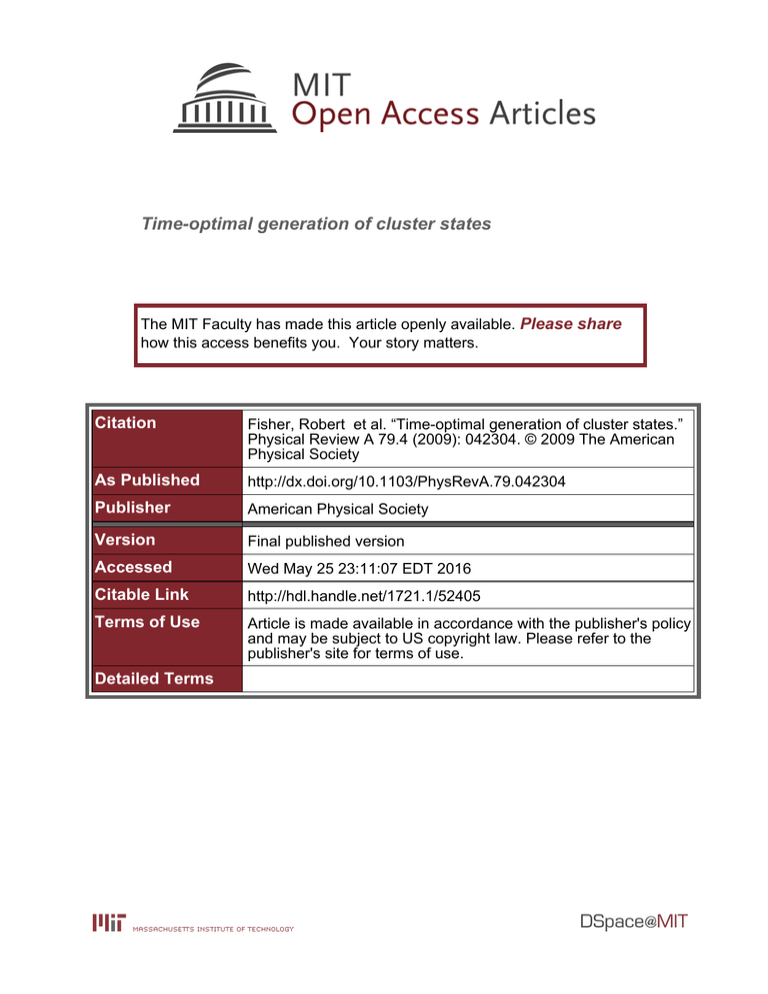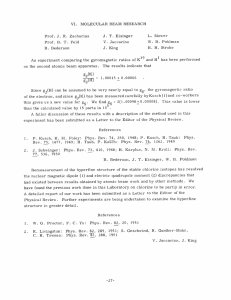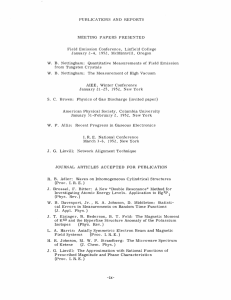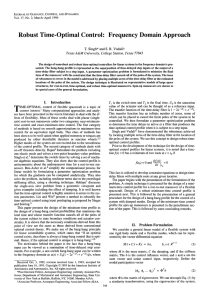Time-optimal generation of cluster states Please share
advertisement

Time-optimal generation of cluster states The MIT Faculty has made this article openly available. Please share how this access benefits you. Your story matters. Citation Fisher, Robert et al. “Time-optimal generation of cluster states.” Physical Review A 79.4 (2009): 042304. © 2009 The American Physical Society As Published http://dx.doi.org/10.1103/PhysRevA.79.042304 Publisher American Physical Society Version Final published version Accessed Wed May 25 23:11:07 EDT 2016 Citable Link http://hdl.handle.net/1721.1/52405 Terms of Use Article is made available in accordance with the publisher's policy and may be subject to US copyright law. Please refer to the publisher's site for terms of use. Detailed Terms PHYSICAL REVIEW A 79, 042304 共2009兲 Time-optimal generation of cluster states Robert Fisher,1,* Haidong Yuan,2 Andreas Spörl,1 and Steffen Glaser1 1 Department of Chemistry, Technische Universität München, Lichtenbergstrasse 4, D-85747 Garching, Germany 2 Department of Mechanical Engineering, MIT, 3-160 Cambridge, Massachusetts 02139, USA 共Received 15 January 2009; published 3 April 2009兲 The definition of a cluster state naturally suggests an implementation scheme: find a physical system with an 1 Ising coupling topology identical to that of the target state and evolve freely for a time of 2J . Using the tools of optimal control theory, we address the question of whether or not this implementation is time-optimal. We present some examples where it is not and provide an explanation in terms of geodesics on the Bloch sphere. DOI: 10.1103/PhysRevA.79.042304 PACS number共s兲: 03.67.⫺a, 03.65.Yz, 82.56.Jn 共2兲 Evolve under the Ising Hamiltonian I. INTRODUCTION The one-way quantum computation model is an approach to quantum information processing where the evolution is driven by local operations and measurements only 关1,2兴. In the experimental realization of such a model, preparation of the highly entangled initial state is therefore of primary concern. These initial states—so-called cluster states—are also interesting in their own right due to the favorable scaling of their entanglement properties 关3,4兴. To date, cluster states of four to six qubits have been realized experimentally in photonic systems 关5,6兴 and are also actively pursued in other architectures, e.g., ion traps 关7兴. In this paper, the efficient generation of cluster states is studied using techniques from optimal control theory 关8,9兴. Given an experimental framework, the aim of these techniques is to find the optimal set of controls to steer the system so that a desired target state or unitary gate is implemented. For systems consisting of two qubits, general analytical solutions exist for the construction of time-optimal unitary transformations 关10,11兴 and state-to-state transfers 关12,13兴 if fast local controls are available. For three or more qubits, analytical solutions are only known in some special cases. In 关14–17兴 it was shown that the time-optimal generation of indirect couplings and trilinear Hamiltonians and the efficient transfer of order along Ising spin chains 关18–20兴 can be reduced to the problem of computing singular geodesics. In addition, powerful numerical methods 关21兴 are available that make it possible to explore the physical limits of timeoptimal control experiments in cases where no analytical solutions are known. The GRAPE algorithm 关21兴 has been used for the generation of quantum gates 关22兴 and state-to-state transfers in NMR 关23兴, as well as for superconducting qubits 关24兴. Here, analytical and numerical techniques are used to investigate the problem of time-optimal cluster state preparation. A cluster state is defined by a graph. To prepare the n-qubit cluster state corresponding to a graph G: 共1兲 Prepare 共locally兲 the initial state 兩In典 ª 冉 兩0典 + 兩1典 *robert.fisher@ch.tum.de 1050-2947/2009/79共4兲/042304共5兲 冑2 冊 丢n Hd = J共t兲 兺 共1 + z共a兲兲共1 − z共a⬘兲兲, 2 具a,a 典 共1兲 ⬘ for a time such that 兰T0 J共t兲dt = 21 , the sum is over all edges of G, where each edge connects the qubit pair 具a , a⬘典. We consider n-qubit systems of the form H = Hd + 兺 u jH共j兲 c , j where the u j are time-dependent functions to be chosen, and the H共j兲 c characterize the available controls. Two different control settings will be considered: 共i兲 Local x and y control on each qubit: 1 = 共j兲 , H共2j−1兲 c 2 x 1 共j兲 H共2j兲 c = y , 2 共2兲 where j 苸 兵1 , 2 , . . . , 2n其. 共ii兲 A single global x control: n H共1兲 c 1 = Fx ª 兺 共j兲 . 2 j=1 x 共3兲 In the following, we allow for fast local controls, i.e., the functions u j are unrestricted. II. THREE COMPLETELY COUPLED QUBITS To shed some light on when a speedup may be possible, we begin with a symmetric three-qubit system which will prove analytically tractable. The qubits are Ising coupled according to the complete coupling graph K3 关25兴, illustrated in Fig. 1. Without loss of generality we will drop the local terms in Eq. 共1兲, as only the entangling part of the operation contributes to the time required. Furthermore J is assumed to be constant. The K3 cluster state is then defined as 冉 . 兩T3典 ª exp − i 冊 1 Hd 兩I3典, 2J where 042304-1 ©2009 The American Physical Society PHYSICAL REVIEW A 79, 042304 共2009兲 FISHER et al. FIG. 1. K3 coupling graph. Hd = J 共1兲 共2兲 共 + z共2兲z共3兲 + z共1兲z共3兲兲. 2 z z The preparation of this state poses the following control problem: maximize F共U兲 ª 兩具T3兩共U兩I3典兲兩 FIG. 3. 共Color online兲 Transfer of Eq. 共5兲 on the Bloch sphere. 1 The u = 0 solution 共blue upper line兲 transfers a to c in a time of 2J . 2 A time-optimal solution 共red lower line兲 transfers a to b in 3冑3J , followed by a hard pulse 共dashed red lower line兲 from b to c in negligible time. 冤 冥 1 0 0 0 0 0 0 0 共4兲 0 0 1 0 0 0 0 0 0 0 0 0 1 0 0 0 subject to equation of motion U̇ = −iHU. In the first instance we will allow for full local control on the qubits and thus specify Hc according to Eq. 共2兲. To maximize the fidelity defined in Eq. 共4兲 in the shortest possible time, we first apply a numerical gradient-ascent algorithm, as detailed in 关21兴. Over a comprehensive range of initial conditions the controls are updated iteratively, incrementing F to a local maximum. The minimal time found by 1 the algorithm to generate 兩T3典 is approximately 0.77⫻ 2J , as seen in Fig. 2共a兲. The significance of this particular value will become clearer later. Figure 2共b兲 shows a numerically optimized solution close to the minimal time. We find in all observed cases that the maximum fidelity does not depend on whether the controls are specified according to Eq. 共2兲 or 共3兲. Motivated by these symmetric solutions, we now restrict ourselves to control setting 共ii兲, specifying Hc according to Eq. 共3兲. This control Hamiltonian, in addition to the drift Hamiltonian and the initial and target states, is symmetric under the cyclic permutation operator, Sª 0 0 0 0 0 0 1 0 0 1 0 0 0 0 0 0 , 0 0 0 1 0 0 0 0 0 0 0 0 0 1 0 0 0 0 0 0 0 0 0 1 and the persymmetry operator P ª 共 x兲 丢 3 , which themselves commute. The dynamics are thus restricted to the simultaneous eigenspace of S and P corresponding to the eigenvalue pair 兵1, 1其. Transforming to a new basis composed of the simultaneous eigenstates of S and P makes this explicit 关26兴. The Hamiltonians are now diagonalized into 2 ⫻ 2 blocks. As we need only consider the 兵1, 1其 block, the state transfer problem can be reduced to 兩I3⬘典 = 1 2 冋冑 册 3 1 → 兩T3⬘典 = 冋 册 1 冑3 , 2 −1 共5兲 under the Hamiltonian H⬘ = Hd⬘ + u共t兲Hc⬘, where Hd⬘ = FIG. 2. 共a兲 Maximum achievable fidelity as a function of the transfer time. 共b兲 A sample solution at the minimal time for initial controls uxj共t兲 = uyj共t兲 = 0. The y controls are omitted as they remain zero, and the x controls are identical on each qubit due to the permutation symmetry of the drift Hamiltonian and the initial and target states. 冋 册 J − 1 0 , 2 0 3 Hc⬘ = 1 2 冋 册 2 冑3 冑3 0 . 共6兲 In order to consider the problem geometrically, we represent the transfer on the Bloch sphere by projecting onto the axes I j ª j / 2, as illustrated in Fig. 3. The initial and final states 兩I3⬘典 and 兩T3⬘典 are identified with vectors a = 21 共冑3 , 0 , 1兲 and b = 21 共−冑3 , 0 , 1兲, respectively, while the Hamiltonians Hd⬘ and Hc⬘ correspond to 共un-normalized兲 rotation axes 共0 , 0 , −2J兲 and 共冑3 , 0 , 1兲, respectively. The trivial solution is to 1 set u共t兲 = 0 and rotate about Hd⬘ for 2J units of time but faster solutions may exist. Motivated by the numerical results in Fig. 2共b兲, we first restrict u共t兲 to the following form: 共1兲 Constant pulse u over time interval 关0 , T兴. 共2兲 Hard pulse of angle at time T. 042304-2 PHYSICAL REVIEW A 79, 042304 共2009兲 TIME-OPTIMAL GENERATION OF CLUSTER STATES FIG. 4. Geometric constructions used. All points shown here lie in the Ix-Iz plane except for b, which lies above it on the upper surface of the sphere. After deriving a time-optimal solution in this setting, we will show that it remains time-optimal when the restrictions are removed and general time-varying pulses are considered. The solution is 共u, ,T兲 = 冉 冊 J − 2 , , , 2 4 3冑3J 共7兲 1 obtained numeriwhich explains the value of T ⬇ 0.77⫻ 2J cally. To demonstrate the time-optimality of this solution, we can consider the geometric constructions in Fig. 4. Starting from a, the task is to transfer the state to any point b on the circle ˆ bce obtained by rotating about Hc⬘. The hard pulse then transfers b to c in an arbitrarily small time. The choice of constant u specifies a rotation axis H⬘, at an angle to Hc⬘. The transfer time to be minimized is where ⬔adb is the angle swept out by the Bloch vector and the length 兩H⬘兩 gives its angular velocity of rotation. Using simple geometry these quantities are expressed in terms of as 冉冑 冊 so that the time is T= 2 冑3 J 3 , 2 sin 兩H⬘兩 = 冑3J sin 冉冑 冊 sin arcsin H⬜ ª 冑3J 2 3 . 2 sin Noting that must lie in the interval 关 3 , 23 兴 for intersection with the circle, we find the maximum at = 2 . The time required is Tmin = 3冑23J . The angle of the final hard pulse is − 2 in this picture, but since 兩Hc⬘兩 = 2 the angle around a normed axis is = − 4 . It remains to show that ˆ bce cannot be reached in less than Tmin when allowing for time-varying pulses. For this we introduce 共− 冑3Iz + Ix兲, which is simply the rotation axis orthogonal to Hc⬘. We consider a generic time-varying control u共t兲. Our aim is to compare each segment of this generic path to the optimal one. Let c1 and c2 be two circles generated by rotating about Hc⬘, chosen to be close enough so that u共t兲 is well approximated by a constant in the interval between them. We consider the time required to travel from c1 to c2 along two different paths: our proposed optimal solution a1 → a2, obtained by rotating purely about H⬜, and a generic path b1 → b2. Suppose the evolution along b1 → b2 takes a time ⌬. This evolution can be decomposed according to the Trotter formula, e−i⌬共H ⬜+ H 兲 v c⬘ = lim 共e−i共⌬/n兲H e−i共v⌬/n兲Hc⬘兲n , ⬜ n→⬁ ⬔adb , T= 兩H⬘兩 ⬔adb = 2 arcsin FIG. 5. 共Color online兲 共a兲 An arbitrary path can be decomposed into rotation about H⬘c and rotation about the orthogonal axis H⬜ via the Trotter decomposition. 共b兲 Rotating our viewpoint by 90°, we see that the optimal trajectory from a1 → a2 minimizes the angle rotated through in each segment 共red兲 when compared to a generic trajectory 共blue兲, i.e., 1 ⬍ 2. 共8兲 which is represented graphically in Fig. 5共a兲. Note that the time required for the operation on the right-hand side of Eq. 共8兲 is still ⌬, as the evolutions along Hc⬘ can be arbitrarily fast. The time ⌬n in a single segment is equal to the angle swept out divided by the norm of H⬜. This angle is minimized in every segment when traveling from a1 → a2, as Fig. 5共b兲 illustrates. The time-optimal solution is therefore to rotate purely about H⬜, which corresponds exactly to solution 共7兲. The speedup here arises from the fact that Hd⬘ and Hc⬘ are not orthogonal, which can be carried over into higher dimensions. FIG. 6. Some of the graphs considered: 共a兲 C4, 共b兲 K4, and 共c兲 G2,3. 042304-3 PHYSICAL REVIEW A 79, 042304 共2009兲 FISHER et al. TABLE I. Minimal times calculated by the GRAPE algorithm with an estimated numerical accuracy of ⫾1 on the last digit. As for the three-qubit example under control setting 共ii兲, included in the first row as a reference, the drift and control can be reduced to matrices H⬘d and H⬘c of size d ⫻ d. Ĥ⬘ indicates a rescaling to unit norm. Graph d 兩具Ĥ⬘d 兩 Ĥ⬘c 典兩 Tmin 共 2J 兲 K3 L3 K4 C4 K5 K6 G2,3 K7 2 3 3 4 3 4 14 10 0.2 0 0 0 0.1 0 0 0.07 0.77 1.00 0.91 1.00 0.70 1.00 1.00 0.60 1 FIG. 7. Numerically optimized sequences for 共a兲 K5 and 共b兲 K 7. IV. SUMMARY III. HIGHER DIMENSIONAL CASES Finally we provide the minimal times for cluster state preparation on a variety of graphs, some of which are illustrated in Fig. 6 to clarify our notation. The times are evaluated numerically using the GRAPE algorithm and are included in Table I. For all of the four-qubit graphs, both control schemes 共i兲 and 共ii兲 were considered, yielding exactly the same minimal times in each case. For the larger graphs only control scheme 共ii兲 was considered, allowing us to reduce the problem to a dimension d using a symmetry-adapted basis, as in Sec. II. The times listed here hold not just for the target state but its entire local unitary orbit, which may include other entangled states of interest 关27兴. While a Bloch sphere analysis is not possible for d ⬎ 2, we find that a connection persists between the nonorthogonality of Hd⬘ and Hc⬘ and the minimal time—in the cases considered, a speedup is possible when Hd⬘ and Hc⬘ are nonorthogonal. Minimal time solutions found by the algorithm for K5 and K7 are shown in Fig. 7. We observe that the effective hard rotation pulse at time T is still present, while the preceding pulse shape is no longer constant. 关1兴 R. Raussendorf and H. J. Briegel, Phys. Rev. Lett. 86, 5188 共2001兲. 关2兴 M. A. Nielsen, e-print arXiv:quant-ph/0504097, Rev. Math. Phys. 共to be published兲. 关3兴 H. J. Briegel and R. Raussendorf, Phys. Rev. Lett. 86, 910 共2001兲. 关4兴 W. Dür and H. J. Briegel, Phys. Rev. Lett. 92, 180403 共2004兲. 关5兴 P. Walther, K. J. Resch, T. Rudolph, E. Schenck, H. Weinfurter, V. Vedral, M. Aspelmeyer, and A. Zeilinger, Nature 共London兲 434, 169 共2005兲. 关6兴 C.-Y. Lu, X.-Q. Zhou, O. Gühne, W.-B. Gao, J. Zhang, Z.-S. Yuan, A. Goebel, T. Yang, and J.-W. Pan, Nat. Phys. 3, 91 共2007兲. 关7兴 H. Wunderlich and C. Wunderlich, e-print arXiv:quant-ph/ 0901.0881, Phys. Rev. A 共to be published兲. For several known two-qubit quantum gates, the “do nothing” operation, i.e., the evolution under a given coupling Hamiltonian, is time-optimal. For example, this is the case for a SWAP gate in the presence of an isotropic Heisenberg coupling 关28兴. Hence it may be surprising to find that it is possible to create cluster states faster than the time required by the straightforward implementation their definition implies. Here we provide examples where this is the case. In particular for three Ising-coupled qubits with identical coupling constants, the problem of time-optimal cluster state generation could be solved analytically via geodesics on a sphere. The numerical techniques used here can also be applied to the problem of cluster state generation in an arbitrary coupling topology, where real experimental values for the coupling constants can be used. This will be addressed in a future work. ACKNOWLEDGMENTS This work has been supported by the Elite Network of Bavaria program QCCC, the integrated EU project QAP, and the Deutsche Forschungsgemeinschaft incentive SFB-631. R.F. and S.G. would like to thank Christof Wunderlich and Thomas Schulte-Herbrüggen for valuable discussions. 关8兴 L. Pontryagin, B. Boltyanskii, R. Gamkrelidze, and E. Mishchenko, The Mathematical Theory of Optimal Processes 共Wiley-Interscience, New York, 1962兲. 关9兴 A. E. Bryson and Y.-C. Ho, Applied Optimal Control 共Hemisphere, Washington, DC, 1975兲. 关10兴 N. Khaneja, R. Brockett, and S. J. Glaser, Phys. Rev. A 63, 032308 共2001兲. 关11兴 H. Yuan and N. Khaneja, Phys. Rev. A 72, 040301共R兲 共2005兲. 关12兴 T. O. Reiss, N. Khaneja, and S. J. Glaser, J. Magn. Reson. 154, 192 共2002兲. 关13兴 N. Khaneja, F. Kramer, and S. J. Glaser, J. Magn. Reson. 173, 116 共2005兲. 关14兴 N. Khaneja, S. J. Glaser, and R. Brockett, Phys. Rev. A 65, 032301 共2002兲. 关15兴 T. O. Reiss, N. Khaneja, and S. J. Glaser, J. Magn. Reson. 042304-4 PHYSICAL REVIEW A 79, 042304 共2009兲 TIME-OPTIMAL GENERATION OF CLUSTER STATES 165, 95 共2003兲. 关16兴 N. Khaneja, B. Heitmann, A. Spörl, H. Yuan, T. SchulteHerbrüggen, and S. J. Glaser, Phys. Rev. A 75, 012322 共2007兲. 关17兴 H. Yuan, S. J. Glaser, and N. Khaneja, Phys. Rev. A 76, 012316 共2007兲. 关18兴 H. Yuan, R. Zeier, and N. Khaneja, Phys. Rev. A 77, 032340 共2008兲. 关19兴 N. Khaneja and S. J. Glaser, Phys. Rev. A 66, 060301共R兲 共2002兲. 关20兴 D. Stefanatos, S. J. Glaser, and N. Khaneja, Phys. Rev. A 72, 062320 共2005兲. 关21兴 N. Khaneja, T. O. Reiss, C. Kehlet, T. Schulte-Herbrüggen, S. J. Glaser, J. Magn. Reson. 172, 296 共2005兲. 关22兴 T. Schulte-Herbrüggen, A. Spörl, N. Khaneja, and S. J. Glaser, Phys. Rev. A 72, 042331 共2005兲. 关23兴 J. L. Neves, B. Heitmann, T. O. Reiss, H. H. R. Schor, N. Khaneja, and S. J. Glaser, J. Magn. Reson. 181, 126 共2006兲. 关24兴 A. Spörl, T. Schulte-Herbrüggen, S. J. Glaser, V. Bergholm, M. J. Storcz, J. Ferber, and F. K. Wilhelm, Phys. Rev. A 75, 012302 共2007兲. 关25兴 D. B. West, Introduction to Graph Theory 共Prentice Hall, Upper Saddle River, NJ, 2001兲. 关26兴 C. N. Banwell and H. Primas, Mol. Phys. 6, 225 共1963兲. 关27兴 M. Hein, J. Eisert, and H. J. Briegel, Phys. Rev. A 69, 062311 共2004兲. 关28兴 T. Schulte-Herbrüggen and O. Sørensen, Concepts Magn. Reson. 12, 389 共2000兲. 042304-5






